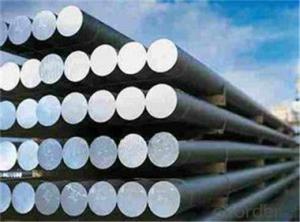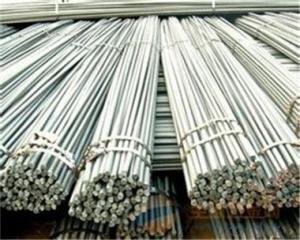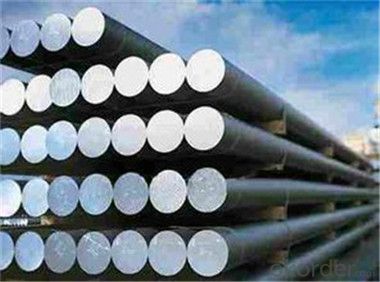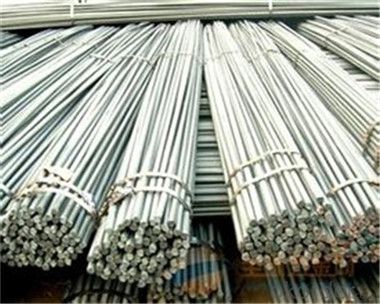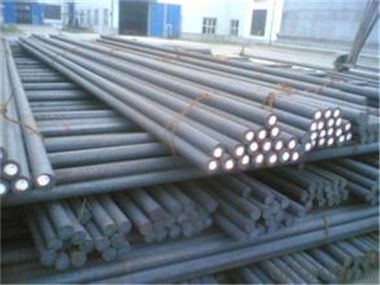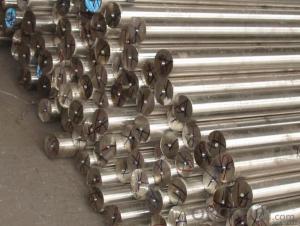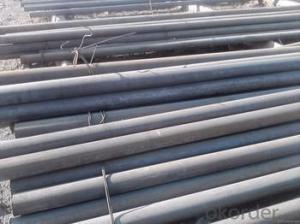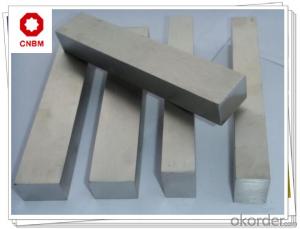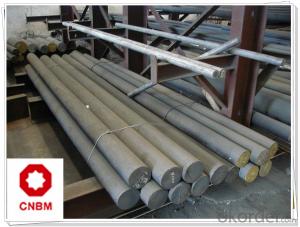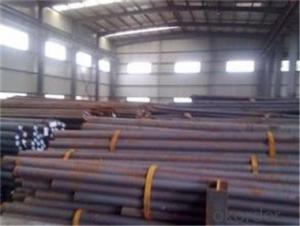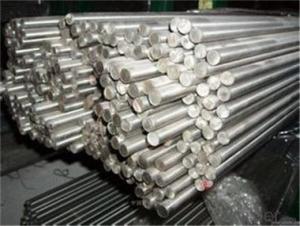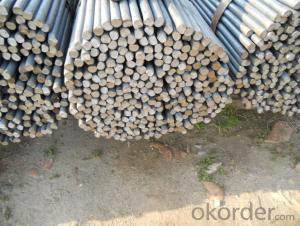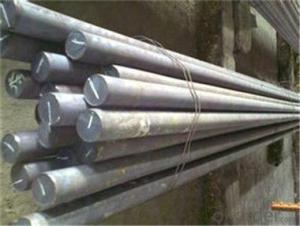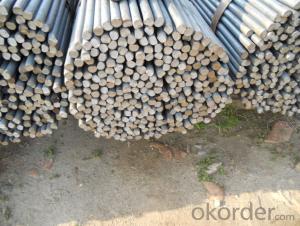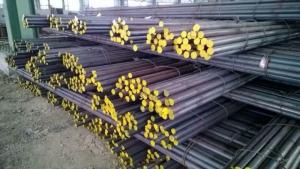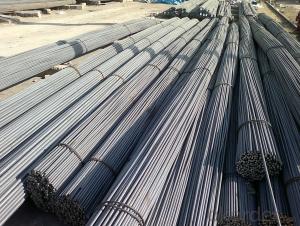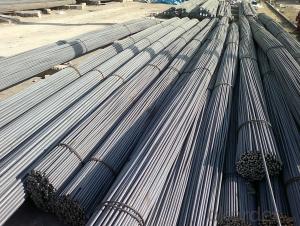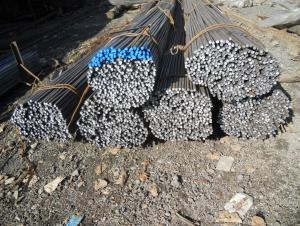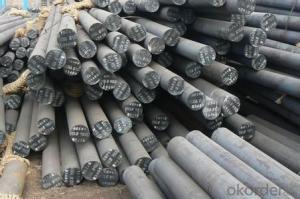Steel Round Bar in China with High Quality Cheaper SAE1018
- Loading Port:
- Tianjin
- Payment Terms:
- TT OR LC
- Min Order Qty:
- 200 m.t.
- Supply Capability:
- 20000333 m.t./month
OKorder Service Pledge
OKorder Financial Service
You Might Also Like
Description of steel round bar:
Mild steel is sometimes referred to as carbon steel or plain steel. Typically, it is stiff and strong. Carbon steelsdo rust easily, but they can be easily painted or primed. They are cheap so they are the normal choice for most fabrications. Mild Steel can be easily cut or drilled to meet your requests.
Mild Steel Round Bar is used for making security grills, screens, Construction and Machine Manufacture.
Festures of steel round bar:
Forged + Annealed + Machining (Peeled/Turned)
Rockwell Hardness: 64-66
Quenching Temperature: 1190-1230
Specifications of steel round bar:
Grade | Chemical Contents % | ||||
C | Si | Mn | P | S | |
45 | 0.42~0.50 | 0.17~0.37 | 0.50~0.80 | ≤0.035 | ≤0.035 |
50 | 0.47~0.55 | 0.17~0.37 | 0.50~0.80 | ≤0.035 | ≤0.035 |
55 | 0.52~0.60 | 0.17~0.37 | 0.50~0.80 | ≤0.035 | |
Images of steel round bar:
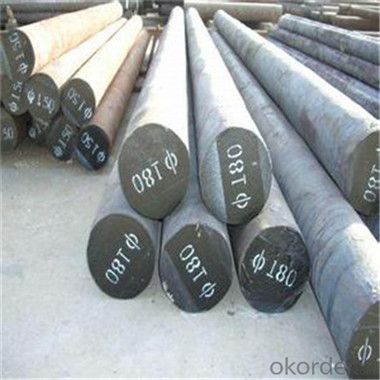
FAQ:
1. What is your package?
Packing situation: standard seaworthy packing or as customer required.
2. How long is the lead time?
Delivery time: 45 days after order confirmed.
3. What payment term do you accept?
Payment: T/T or L/C at sight.
- Q: What kind of nuts do you need for round 20 rounds?
- The M22 thread can be made, if made M20, need a car off some. You may be talking about support, depending on how big your lead screw is.Stainless steel round bar refers to the solid steel strip with round section. The specifications are expressed in millimeters of diameter, such as "50", which means a stainless steel round bar of 50 millimeters in diameter.
- Q: Can steel round bars be used in the production of musical instruments?
- Certainly! Musical instruments can indeed be produced using steel round bars. Steel, being a versatile material, possesses a wide array of desirable attributes including strength, durability, and resonance. Although wood is typically the go-to material for crafting musical instruments, steel can be utilized in specific instances to augment the instrument's sound and performance. For instance, steel round bars can be implemented in the fabrication of various components such as keys or valves for wind instruments like saxophones or trumpets. Moreover, these bars can be employed to construct the internal support systems in instruments like guitars or cellos, thereby providing stability and enriching tonal qualities. Furthermore, steel round bars can be employed in the construction of percussion instruments such as steel drums or xylophones, where their robust and resonant attributes are highly sought after. On the whole, although wood remains the more prevalent choice in the realm of musical instrument production, steel can certainly be employed in specific scenarios to attain desired sound characteristics and structural integrity.
- Q: What are the safety precautions to be taken while handling steel round bars?
- To prevent accidents and injuries when working with steel round bars, it is crucial to adhere to specific safety measures. Here are several precautions that should be taken: 1. Personal Protective Equipment (PPE) is essential. Wear suitable gear, such as safety goggles, gloves, and steel-toe boots, to safeguard against potential hazards like flying debris, sharp edges, and crushing injuries. 2. Employ proper lifting techniques. Bend your knees and use your leg muscles instead of your back to avoid strain or back injuries. Do not attempt to lift heavy steel round bars alone; seek assistance or utilize lifting equipment like cranes or forklifts. 3. Ensure secure storage. Store steel round bars in a stable and secure designated area or rack. Organize and stack them correctly to prevent falling or rolling onto individuals. 4. Utilize appropriate handling tools. Use tools like tongs or lifting hooks to handle steel round bars. Refrain from using your hands or fingers directly to avoid cuts or pinching injuries. 5. Conduct inspections. Before handling steel round bars, inspect them for defects, sharp edges, or protrusions that may pose safety risks. Report any issues to the appropriate personnel and do not use the bars until they are repaired or replaced. 6. Maintain clear communication with co-workers. Especially in situations involving multiple individuals, employ hand signals or verbal cues to coordinate movements and avoid accidental collisions. 7. Ensure proper storage and transportation. When storing or transporting steel round bars, secure them adequately and provide sufficient support to prevent shifting, sliding, or falling during movement. 8. Provide comprehensive training. Train all personnel involved in handling steel round bars, covering proper lifting techniques, the use of PPE, and awareness of potential hazards and safety procedures. By adhering to these safety precautions, the risk of accidents and injuries while working with steel round bars can be minimized. Always prioritize safety to create a secure working environment for yourself and those around you.
- Q: What is the difference between a polished and a cold drawn steel round bar?
- A polished steel round bar is a steel bar that has undergone a polishing process. This process involves using abrasive materials to remove any surface imperfections and create a smooth, shiny finish. The purpose of polishing is to enhance the visual appearance and corrosion resistance of the steel bar. It is commonly used for decorative or architectural purposes where aesthetics are important. On the other hand, a cold drawn steel round bar is produced using a different manufacturing process. In this method, a steel bar is pulled through a die at room temperature to reduce its diameter and increase its length. This process results in a bar with a more precise and uniform diameter, as well as improved mechanical properties such as higher tensile strength and dimensional accuracy. Cold drawing also improves the surface finish, although it may not achieve the same level of smoothness and shine as a polished bar. In summary, the main distinction between a polished and a cold drawn steel round bar lies in the manufacturing process and the resulting properties. Polishing is done for aesthetic purposes, creating a smooth and shiny finish. On the other hand, cold drawing is performed to enhance the dimensional accuracy and mechanical properties of the steel bar.
- Q: Can steel round bars be used for making steering linkages?
- Making steering linkages is one application where steel round bars can be used. Steel round bars have a wide range of uses in automotive and mechanical engineering due to their strength, durability, and resistance to wear and tear. Steering linkages play a crucial role in a vehicle's steering system as they transmit the steering input from the steering wheel to the wheels. By using steel round bars, the necessary strength and rigidity are provided, ensuring efficient and reliable steering performance. However, it is important to consider other factors like specific design requirements, weight considerations, and desired level of flexibility or torsional properties when choosing the appropriate type and size of steel round bar for steering linkages.
- Q: How do I choose the right grade of steel round bar for my application?
- Choosing the right grade of steel round bar for your application requires careful consideration of several factors. Here are some steps to help you make an informed decision: 1. Determine the application requirements: Start by understanding the specific demands of your application. Consider factors such as load-bearing capacity, corrosion resistance, temperature resistance, and any specific industry standards or regulations that may apply. 2. Identify the required mechanical properties: Depending on the application, you may need specific mechanical properties such as strength, hardness, toughness, or ductility. Identify the required values for these properties and prioritize them based on their importance to your application. 3. Consider the environmental conditions: Evaluate the conditions in which the steel round bar will operate. This includes factors such as exposure to moisture, chemicals, high temperatures, or abrasive environments. Some grades of steel are more resistant to corrosion or heat, making them more suitable for specific conditions. 4. Consult with experts: If you are unsure about the best grade of steel for your application, seek advice from professionals such as metallurgists, engineers, or suppliers. They can provide valuable insights based on their expertise and experience. 5. Compare different grades: Once you have a clear understanding of your application requirements, research and compare different grades of steel round bars available on the market. Consider factors such as composition, manufacturing process, and specific properties of each grade. Look for grades that closely match your requirements. 6. Review industry standards and specifications: Check if there are any industry standards or specifications that dictate the use of specific grades for your application. These standards can provide guidance and ensure compliance with safety and quality requirements. 7. Evaluate cost-effectiveness: Evaluate the cost-effectiveness of different grades by considering factors such as initial purchase cost, maintenance and replacement costs, and the overall lifespan of the steel round bar. 8. Conduct tests and trials: If possible, conduct tests or trials using different grades of steel round bars to assess their performance in your specific application. This can provide valuable data and help you make a more informed decision. By following these steps and considering all relevant factors, you can choose the right grade of steel round bar that will meet the demands of your application efficiently and effectively.
- Q: What is the minimum tensile strength of steel round bars?
- The minimum tensile strength of steel round bars can vary depending on the specific grade or type of steel being used. However, common steel grades typically have a minimum tensile strength of around 400 MPa (megapascals) or 58,000 PSI (pounds per square inch).
- Q: Are steel round bars suitable for use in the manufacturing of springs?
- Yes, steel round bars are suitable for use in the manufacturing of springs. Steel round bars offer excellent strength, durability, and elasticity, which are crucial characteristics for springs. Additionally, steel round bars can be easily machined, formed, and heat-treated to achieve the desired properties for specific spring applications.
- Q: How do steel round bars compare to stainless steel round bars?
- Steel round bars and stainless steel round bars differ in their composition, making them suitable for various applications. The composition of steel mainly consists of iron with small amounts of carbon and other elements, whereas stainless steel is an alloy composed of iron, chromium, and often other elements like nickel or molybdenum. This unique composition gives stainless steel its distinctive properties, such as corrosion resistance. Both steel and stainless steel round bars can be manufactured to have high tensile strength. However, stainless steel generally has higher tensile strength compared to regular steel, making it more suitable for applications requiring additional strength and durability. Another significant difference lies in their resistance to corrosion. Stainless steel round bars have excellent corrosion resistance due to the presence of chromium in their composition, making them ideal for applications exposed to moisture, chemicals, or other corrosive environments. On the other hand, steel round bars are more prone to rust and corrosion and may need additional protective coatings in such environments. In terms of cost, steel round bars are generally more affordable compared to stainless steel round bars. The higher cost of stainless steel is attributed to its unique properties and the additional alloying elements required in its production. Both steel and stainless steel round bars have advantages and specific applications. Steel round bars are commonly used in construction, manufacturing, and general-purpose applications where corrosion resistance is not a primary concern. In contrast, stainless steel round bars find extensive use in industries such as food processing, chemical processing, medical equipment, and marine applications where corrosion resistance is crucial. In conclusion, the choice between steel round bars and stainless steel round bars depends on the specific requirements of the application. Steel round bars are more cost-effective but may require additional corrosion protection, while stainless steel round bars offer superior corrosion resistance and strength.
- Q: Can steel round bars be used in the automotive manufacturing industry?
- Yes, steel round bars can be used in the automotive manufacturing industry. They are often utilized for various applications, such as the production of engine components, suspension systems, and structural parts. Steel round bars offer excellent strength, durability, and machinability, making them suitable for meeting the demanding requirements of the automotive industry.
Send your message to us
Steel Round Bar in China with High Quality Cheaper SAE1018
- Loading Port:
- Tianjin
- Payment Terms:
- TT OR LC
- Min Order Qty:
- 200 m.t.
- Supply Capability:
- 20000333 m.t./month
OKorder Service Pledge
OKorder Financial Service
Similar products
Hot products
Hot Searches
Related keywords
